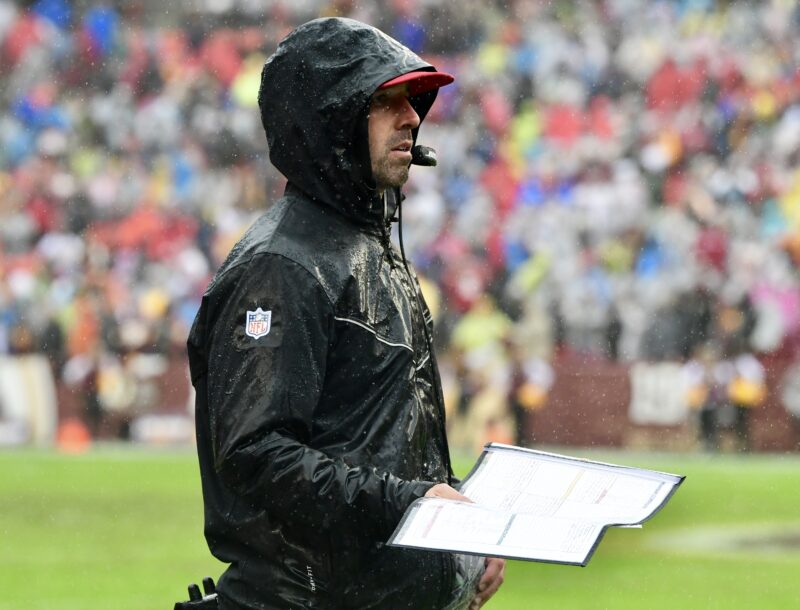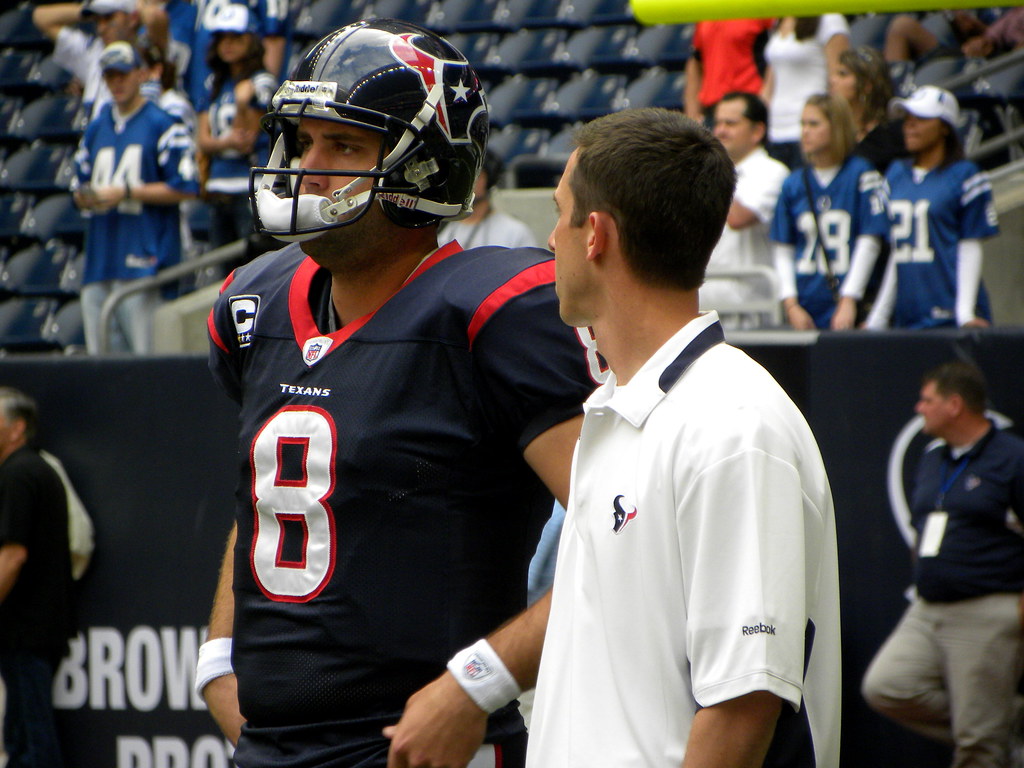The NFL has seen a change in the way offensive and defensive coordinators approach game-planning since Sean McVay took over as head coach of the Rams.
Sean McVay is the youngest head coach in NFL history at age 33. He has been a part of the Rams organization since 2008 and was hired as an offensive assistant under Jeff Fisher. At age 26, Kyle Shanahan became the youngest head coach in NFL history after being hired by the 49ers.
6 a.m. ET
- Nick Wagoner is a musician from the United States.
- For nine years, I covered the Rams for stlouisrams.com.
- Previously, I covered football at the University of Missouri.
- Pro Football Writers of America member
- Lindsey Thiry is a thirty-year-old woman.
- For the Los Angeles Times, I covered the Rams for two years.
- Previously, I wrote about the Falcons.
- Has written about the NBA, as well as college football and basketball.
SANTA CLARA (California) – Football is never far from San Francisco 49ers coach Kyle Shanahan’s thoughts, no matter where he is or what he’s doing.
Shanahan went to a local cinema for a family birthday celebration on a recent Friday night, when the animated picture “The Addams Family 2” was playing on the big screen. Shanahan hadn’t spent much time reveling in Snoop Dogg’s swipe at the voice of Cousin Itt by the time he departed.
Instead, he spent the whole one-hour, 47-minute run time on his iPad, coming up with fresh play concepts, many of which incorporated his most important weapon: pre-snap motion.
Shanahan stated, “It was wonderful because I got to sit there with my iPad for two hours and do that sort of things.” “Leaving your work is difficult, and I suppose I love thinking about football.”
Shanahan always has his iPad or a pen and paper handy, whether he’s eating dinner, traveling in his vehicle, or resting in bed, in case inspiration hits and he wants to quickly scribble down an idea.
Shanahan shares this interest with Los Angeles Rams coach Sean McVay, who will face Shanahan’s Niners on Monday Night Football at Levi’s Stadium in an attempt to end a four-game losing run (8:15 p.m. ET, ESPN). There will be a lot of comparable offensive ideas in this game, but none more so than the duo’s mutual love of movement before the snap.
Shanahan’s 49ers and McVay’s Rams have ranked first and ninth in the NFL in pre-snap motion utilization, with 67.8 percent and 46.2 percent, respectively, since taking over their roles in 2017.

With receiver Robert Woods out for the season due to a ruptured left ACL and Odell Beckham Jr. now in the mix, it’s uncertain how much the Rams’ usage of motion would shift, but Beckham’s use of motion would be a significant turnaround if he was required to use it much. Beckham only moved eight times before the play on 274 offensive snaps with the Cleveland Browns this season.
To put it another way, Beckham’s role will most certainly be altered, at least in the beginning.
“I believe Odell understands the game,” McVay added. “But, one again, it’s difficult for me to say anything until we go out there and perform some various things while watching him move about.”
Given how often both teams employ pre-snap motion, it’s no wonder that even when they’re not supposed to be doing anything else, both coaches spend their free time conjuring up new shifts.
McVay laughed about his play-design process, saying, “Usually, I’m delirious or have far too many coffees.” “Usually, it’ll be a good idea or a bad idea, and there’ll be a lot more bad ideas than good ideas coming from me on some of those things.”
The findings show that there isn’t much stupid in the world. Since 2017, the 49ers have been third in the NFL in terms of points scored (9.89 per game) and yards per play (5.81) on snaps with motion. Off motion plays, the Rams are fourth in yards per play (5.86) and are tied for 13th in points per game (7.1).
Shanahan’s passion for pre-snap motion stems back to his early coaching days, when he worked as an offensive quality control coach for Jon Gruden and the Tampa Bay Buccaneers in 2004 and 2005, and as a wide receivers coach for the Houston Texans in 2006.
McVay cites Gruden and Shanahan as two of his numerous coaching inspirations. His interest in it has only risen as he has progressed through the ranks of head coach, owing to his observations of how the Rams used quick receiver Tavon Austin in motion before he came and how he might continue to enhance Austin’s involvement in his first season.
“You try to understand, ‘All right, what is the objective of this play?’ and how can you use it to generate numbers, modify the arithmetic, and give yourself better angles from an offensive standpoint when you’re hitting the 11 people on defense,” McVay said. “It’s been a developing and continuous process, but there’s always been a goal in mind. It’s not only for the sake of looking cool.”
‘Taco, taco, hot sauce, hot sauce,’ says the narrator.

It’s typical to hear two voices on the 49ers’ side before each game: quarterback Jimmy Garoppolo and fullback Kyle Juszczyk.
Juszczyk not only shifts before the snap at a league-high 41% of the time (among players with at least 100 plays), but he also assists Garoppolo with offensive direction. Juszczyk is the air traffic controller if Garoppolo is the pilot piloting the jet.
After the Niners exit the huddle, Juszczyk will make check calls, notify Garoppolo that the play has more than one shift so he can slow his cadence, point out stuff the defense is exhibiting, and yell out gibberish, among other things.
Yes, Juszczyk uses phony calls as another technique to confuse the defender for consistency and to avoid tipping off the defense.
• Lamar’s relationship with Donovan Mitchell What Jets’ White took away from Dak Prescott • Barmore gets the respect of Belichick Pitts and Parsons will meet again. • Parker’s ‘authenticity’ in Denver
That’s coming from a fifth-year player who has made two Pro Bowl appearances who motions on 26% of his plays, the second-highest percentage on the team.
“It’s still difficult,” Kittle said. “It’s something you have to learn and go through on a daily basis.”
The subtleties of the pre-snap shifts are emphasized by the 49ers coaching staff when they get access to players in the spring. According to offensive coordinator Mike McDaniel, the idea is to make it so natural that players don’t even notice when they’re called.
To assist, the 49ers have developed their system so that players listen for certain portions or keywords, as Juszczyk refers to them. A playcall might include up to 20 words, but a tight end could only be listening for the four that pertain to him.
“It’s basically written out in a manner that we can organize things so that when they hear it, they know where they need to go,” said Bobby Slowik, the passing game coordinator. “They’ll receive the playcall and execute the play once they know where they need to be.”
Rams quarterback Matthew Stafford has only been in Los Angeles for a few weeks, but he’s already become used to McVay showing up in a conference room, hilariously overcaffeinated and with a fresh set of movements to try out.
Stafford said, “He’s completely aware of it.” “When he says something like, ‘Maybe I had a couple of too many cups of coffee this morning trying to figure this one out,’ he’ll make fun of himself. But nine times out of ten, it’s a game-winning hit.”
Taking those classroom concepts to the field is a new challenge that requires both mental and physical stamina. Because of the added toll of the movements, players who already run a long distance in games must be in even better form.
Teams shift 45.4 percent of the time before the ball is snapped in the NFL. The league average was 34.9 percent only four years ago. Given the amount of coaches who have worked with Shanahan and McVay around the league, it’s logical to assume that number will continue to climb.
Shanahan and McVay are just as likely to be at the vanguard of discovering new ways to extend what they’re currently doing.
Shanahan said, “I’m not particularly adept at thinking about stocks and investing.” “I’m considering various techniques to draw plays, but I believe it ultimately comes down to how you see defenses. There are only so many ways to move five people, so you don’t simply do it for the sake of doing it. You do it to assist one of your players or because you see something that you believe will have an impact on the defense.”
Related Tags
- get back coach
- rams coaching staff
- youngest nfl coach

